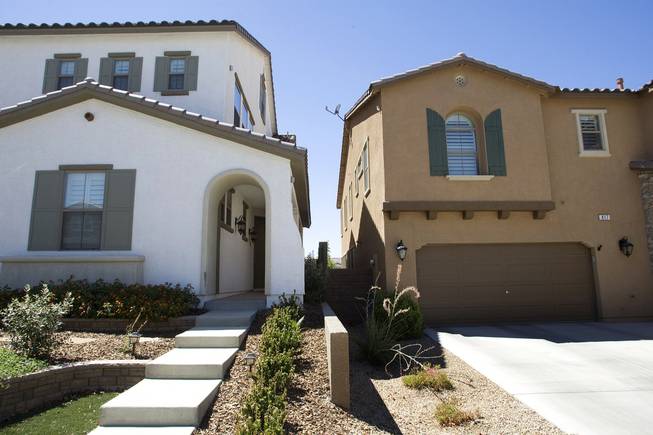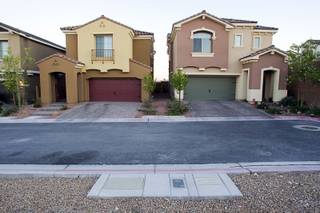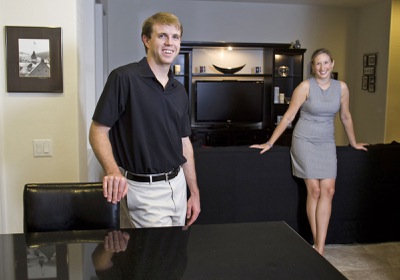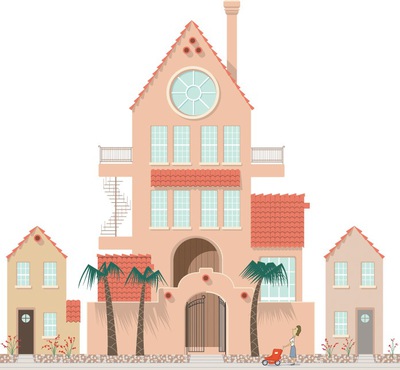
Homes in Henderson’s Montclaire subdivision are among the valley’s minimansions. Homes are being built smaller since the recession hit.
Saturday, Sept. 25, 2010 | 2 a.m.
Sun coverage
Sun archives
- Number of foreclosures in Nevada continues to drop (9-15-2010)
- HUD secretary says Las Vegas housing market stabilizing (9-11-2010)
- Walking away from a mortgage comes with risks (9-3-2010)
- Analysts disagree on falling house prices (8-6-2010)
- From building boom to recessionary bust, local real estate market was a wild ride that went south (6-11-2010)
- Tax credit’s effect peters out, pointing to a lull in housing sales (5-13-2010)
- Bank foreclosures, delinquent mortgages continue to rise (5-12-2010)
- Tax credit’s end fails to help Las Vegas home sales (5-10-2010)
- Housing market awaits impact of tax credit’s expiration (5-7-2010)
- Las Vegas has more than its share of troubled properties (5-7-2010)
Andrew and Lindsey Patterson had their pick of the litter when shopping for a new home after moving from Chicago to Las Vegas in 2009. Before choosing a comfortable, 2,000-square-foot home in Summerlin, they looked at bigger and more extravagant dwellings on the foreclosure market, but passed.
The traumatized real estate market made them cautious. Bigger homes cost more to maintain and furnish. It felt like a risk in uncertain times.
“We looked (at larger homes),” Lindsey said, “but in the end, it didn’t make sense for us.”
“They had more space than we needed,” said Andrew, 27, who works in gaming. “We focused on what we could afford and not going outside those limits.”
The Pattersons were not seduced by size and opulence, a sign that the days of minimansions seem to be waning. Once thought to be safe investments and symbols of success, many huge homes stand empty across the Las Vegas Valley.
Dominating their tiny lots, many marked with foreclosure notices, they are towering monuments to a boom that began less than a decade ago and ended as quickly.
As Las Vegas struggles through the recession, homebuilders are changing their vision of what families want in a house. Large homes are out of favor. Economy-battered buyers are thinking smaller. And in Las Vegas, this is a seismic shift in the marketplace.
Nasser Daneshvary, director of UNLV’s Lied Institute for Real Estate Studies, said homebuyers fear a double-dip recession and a poor return on real estate investments. The future is too uncertain. They are pulling back.
“People are jittery. They’ve shifted their way of thinking,” Daneshvary said. “Fewer people think of real estate as a high-return investment. The expectations for a recovery are not there.”
After all, home prices in the valley have plummeted to less than half of their peak of 2004-06, he said.
Buyers are seeking homes within their means that will serve them for five to 10 years — a major change from prerecession days, when many people kept a home for one or two years and moved up to a bigger, fancier one.
In response, homebuilders and their architects are going back to the drawing board and constructing smaller homes with an eye for amenities to boost a resident’s quality of life and green technologies to save on utility bills.
Buyers think prices are bottoming out, but doubts linger.
For example, Eddy Grifford, 30, moved back to Las Vegas, where he was born, a year ago with his wife, Christine. Like the Pattersons, he browsed the foreclosure market and considered homes bigger than the 1,700-square-foot house that he eventually bought in the master-planned community of Providence, he said. Grifford, a financial planner, envisions living there for a while, but still wanted a safe bet.
Grifford was “cautious” and concerned with “risk aversion” as he looked for a home where he and Christine can expand their family, he said.
“If we buy a minimansion, and something happens, what are we going to do?” he said. “You want something where, in that worst-case scenario, you can still get away with scratches instead of the deep cut that everybody is still recovering from nowadays.”
Rick Shelton, president of the Greater Las Vegas Association of Realtors, describes the change with an analogy.
“I’d love to drive a Mercedes, but if I have to settle for a Buick in lieu of that, then that’s what I’m going to do,” he said.
“They’re looking at their budgets. They’re looking at the fear of the economic circumstances.”
The development where the Pattersons live — Villa Trieste, one of Pulte Homes’ 12 communities in the valley — is an example of the change. Homes, usually up to 2,000 square feet, are outfitted with advanced climate control systems. Touch-screen panels come standard, allowing homeowners to monitor energy use and power down during peak hours. Solar panels and tankless water heaters are installed in every home to save energy.
Homebuilders including KB Home, which has communities throughout the country and 18 in the valley, and local builder Desert Wind Homes, said they have noticed a distinct change in consumers’ tastes.
Although the housing boom sparked higher-density, bigger homes on smaller lots, the trend has turned back to smaller houses on bigger lots, said Jim Widner, regional president of KB Home. That means bigger yards and home sizes that are shrinking from close to 3,000 square feet before the housing bust to less than 2,000 square feet now.
“People are much more focused on what they need versus what they may be able to afford,” Widner said. “It is a pure, pragmatic, bottom-line approach.”
Mick Galatio, owner of Desert Wind Homes, said interest in houses of less than 2,000 square feet is markedly stronger than demand for homes at 2,500 square feet or more. “People are buying smaller houses,” he said.
It is a striking reversal from the mentality before the recession. Home sizes increased steadily from 1999 to 2009, according to an MSNBC analysis of the American Housing Survey collected by the U.S. Census Bureau.
Dena Duresh, an administrator in the Clark County School District who also lives in Villa Trieste, said she saw foreclosed residences twice the size of her 1,500-square-foot home available for the same price. But like the Pattersons, she considered the cost of utilities in a bigger house and maintaining a home twice as big as she needed. It felt excessive, so she bought smaller, she said.
“I wasn’t interested in going bigger just because I could afford it,” she said. “I wanted a new home that was the right size.”
Those minimansions, sometimes dubbed “McMansions,” are usually larger than 3,000 feet and characterized by an indefinite architectural design and a tendency to come in droves.
Although Daneshvary expects the Las Vegas Valley’s housing market to recover — it may lag behind the rest of the U.S. — he said he doesn’t expect it to return to the boom days or see a reappearance of mass-market luxury apartments and homes.
Nor does he imagine homebuyers will quickly forget the hardships of the past two years.
The face of the valley, it seems, might be permanently changed.




Join the Discussion:
Check this out for a full explanation of our conversion to the LiveFyre commenting system and instructions on how to sign up for an account.
Full comments policy